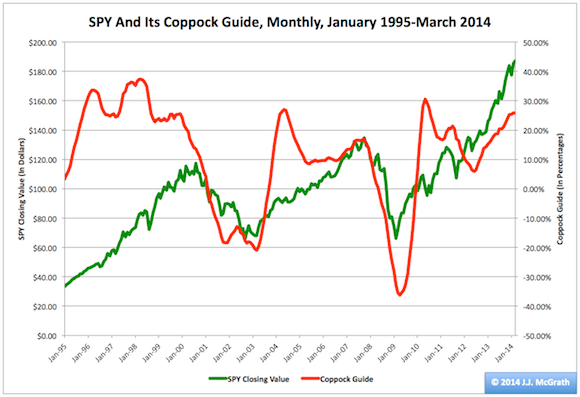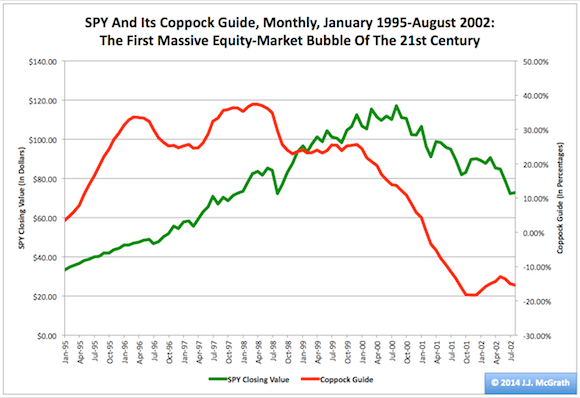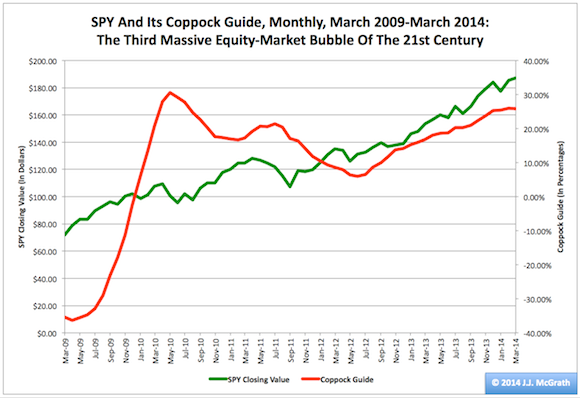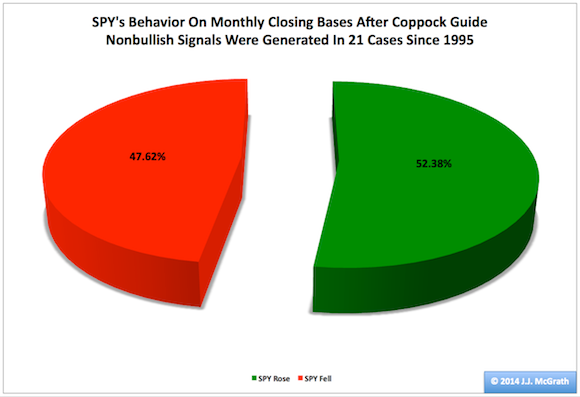The Coppock guide, aka either the Coppock curve or the Coppock
indicator, is a long-term indicator of price movements in major stock-market
indexes introduced by Edwin S. Coppock in Barron’s
more than half a century ago. Both the indicator’s history and its methodology
are interesting in themselves, but my focus here is on its relevance to SPY.
Figure 1: SPY And Its
Coppock Guide, The Complete History
Note: The SPY closing-value
scale is on the left, and the Coppock guide scale is on the right.
Source: This J.J.’s
Risky Business chart is based on
proprietary analyses of Yahoo Finance adjusted monthly share-price data and those data themselves.
Coppock developed his long-term guide not to generate both
bullish and bearish signals but to generate only bullish signals. However, I
employ it to generate either bullish or nonbullish signals. It is extremely
important to bear in mind that in the context of the Coppock guide a nonbullish
signal is not equivalent to a bearish
signal. In my use of the indicator, I anticipate SPY may advance after a
bullish signal and expect it might do anything following a nonbullish signal
(i.e., move higher, move lower or trade sideways).
Figure 2: SPY, Its
Coppock Guide And Bubbliciousness, Part One
Note: The SPY closing
value scale is on the left, and the Coppock guide scale is on the right.
Source: This J.J.’s
Risky Business chart is based on
proprietary analyses of Yahoo Finance adjusted monthly share-price data and
those data themselves.
The first massive equity-market bubble of the 21st century
began to inflate around the same time the SPY Coppock guide generated an
initial bullish signal in January 1995 and started to deflate shortly after it
generated an initial nonbullish signal in December 1999: On an adjusted
share-price basis, SPY hit a monthly closing high of $115.43 in March 2000.
(Sadly, I did not come across the Coppock guide until 2003, so I personally was
unable to profitably employ the indicator during the period covered in Figure
2.)
Figure 3: SPY, Its
Coppock Guide And Bubbliciousness, Part Two
Note: The SPY closing
value scale is on the left, and the Coppock guide scale is on the right.
Source: This J.J.’s
Risky Business chart is based on
proprietary analyses of Yahoo Finance adjusted monthly share-price data and
those data themselves.
The second massive equity-market bubble of the 21st century
began to inflate around the same time the SPY Coppock guide generated an
initial bullish signal in March 2003 and started to deflate shortly after it
generated an initial nonbullish signal in October 2007: On an adjusted
share-price basis, SPY hit a monthly closing high of $134.65 the latter month.
Figure 4: SPY, Its
Coppock Guide And Bubbliciousness, Part Three
Note: The SPY closing
value scale is on the left, and the Coppock guide scale is on the right.
Source: This J.J.’s
Risky Business chart is based on
proprietary analyses of Yahoo Finance adjusted monthly share-price data and
those data themselves.
The third massive equity-market bubble of the 21st century
began to inflate around the same time the SPY Coppock guide generated an
initial bullish signal in April 2009 and has not yet started to deflate: On an
adjusted share-price basis, SPY to this date has hit a monthly closing high of
$187.01 in March.
Figure 5: SPY’s
Behavior Subsequent To Initial Bullish Signals
Source: This J.J.’s
Risky Business chart is based on
proprietary analyses of Yahoo Finance adjusted monthly share-price data.
The SPY Coppock guide’s initial bullish signals collectively
have done an excellent job in forecasting the future upward movements of the
ETF on monthly closing bases. In 22 cases since January 1995, these signals
have been successful on 18 occasions, or 81.82 percent of the time, and unsuccessful
on four occasions, or 18.18 percent of the time.
Figure 6: SPY’s
Behavior Subsequent To Initial Nonbullish Signals
Source: This J.J.’s
Risky Business chart is based on
proprietary analyses of Yahoo Finance adjusted monthly share-price data.
In contrast, the SPY Coppock guide’s initial nonbullish
signals collectively have done nothing in predicting any movements of the ETF
on monthly closing bases. In 21 cases since January 1995, SPY has followed these
signals by rising on 11 occasions, or 52.38 percent of the time, and falling on 10 occasions, or 47.62 percent of the time. Sheesh!
The Bottom Lines
The SPY Coppock guide has clearly told me the old long-term
trend upward has ended, but it has not clearly told me that a new long-term
trend downward has begun. At this moment, it is telling me SPY may move higher,
lower or sideways. The indicator is thus sending a mixed message. However, it is
a very different message than the one I received each of the previous 20
months, commencing in June 2012. And this message is not the only one I have
had delivered recently, as follows:
• The U.S. Federal Open Market Committee has continued to
taper the Federal Reserve’s current quantitative-easing program. FOMC first announced it would cut its
monthly asset purchases to $75 billion in January from $85 billion in December;
the committee then said it would reduce
them to $65 billion in February from $75 billion in January; and it most recently said it would trim them to
$55 billion in April from $65 billion in March. The changes in monetary policy are likely to have
an effect on the equity market in general and SPY in particular, as discussed
in “Building A Martin Zweig-Like Fed Indicator Integrating Innovations Of The
21st Century.”
• The stock market is already overvalued, as indicated by 2013 Nobel Prize-winning
economist Robert J. Shiller’s cyclically adjusted
price-earnings ratio.
As a result, there is little or no reason for SPY (or its underlying
index) to rise from its current level based on valuation.
• Speculation
in the market is close to an all-time high, as suggested by “NYSE Margin
Debt Hits All-Time High Of $465.72 Billion In February, With Risk Rank At No. 2.”
Therefore, I anticipate a dramatic turn in money flow, to outward from inward,
sooner or later.
Still, the history of the SPY Coppock guide leads me to
anticipate a certain amount of whipsawing between signals during the next two
quarters (at least). I would be completely unsurprised to see the indicator
generate first a bullish signal in either May or June and then a nonbullish
signal on its heels.
And, of course, I also would be completely unsurprised to
see this whipsawing accompanied by the Chicago Board Options Exchange Volatility Index continuing to wend its way
higher, as described in “S&P 500 Flattish As VIX Rises In 2014.” Ay
caramba!
Correction: Please note the Figure 6 graphic and text originally published has been changed to correct a mischaracterization of SPY’s movement on a monthly closing basis in the wake of one of the 21 initial nonbullish signals flashed by the Coppock guide.
Correction: Please note the Figure 6 graphic and text originally published has been changed to correct a mischaracterization of SPY’s movement on a monthly closing basis in the wake of one of the 21 initial nonbullish signals flashed by the Coppock guide.
Disclaimer: The opinions
expressed herein by the author do not constitute an investment recommendation,
and they are unsuitable for employment in the making of investment decisions.
The opinions expressed herein address only certain aspects of potential
investment in any securities and cannot substitute for comprehensive investment
analysis. The opinions expressed herein are based on an incomplete set of
information, illustrative in nature, and limited in scope. In addition, the
opinions expressed herein reflect the author’s best judgment as of the date of
publication, and they are subject to change without notice.





